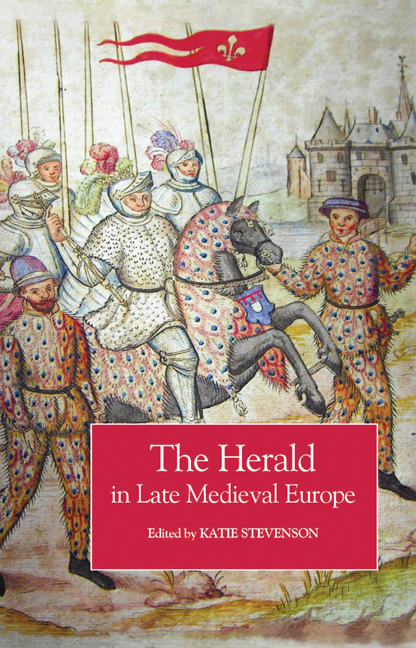Book contents
- Frontmatter
- Contents
- List of Illustrations
- Notes on Contributors
- Acknowledgements
- Abbreviations
- 1 Introduction
- 2 The Development of the Office of Arms in England, c. 1413–1485
- 3 Ancient Precedent or Tudor Fiction? Garter King of Arms and the Pronouncements of Thomas, Duke of Clarence
- 4 Jurisdiction, Authority and Professionalisation: The Officers of Arms of Late Medieval Scotland
- 5 The March of Brittany and its Heralds in the Later Middle Ages
- 6 City Heralds in the Burgundian Low Countries
- 7 King of Arms of the Ruwieren: A Special Function in the German Empire
- 8 Heraldry, Heralds and Politics in the Republic of Florence in the Late Middle Ages
- 9 Tournaments, Heraldry and Heralds in the Kingdom of Poland in the Late Middle Ages
- 10 A time when ‘fools and dwarfs were highly esteemed’? Seeking the Late Medieval Scandinavian Herald
- Index
7 - King of Arms of the Ruwieren: A Special Function in the German Empire
Published online by Cambridge University Press: 26 October 2017
- Frontmatter
- Contents
- List of Illustrations
- Notes on Contributors
- Acknowledgements
- Abbreviations
- 1 Introduction
- 2 The Development of the Office of Arms in England, c. 1413–1485
- 3 Ancient Precedent or Tudor Fiction? Garter King of Arms and the Pronouncements of Thomas, Duke of Clarence
- 4 Jurisdiction, Authority and Professionalisation: The Officers of Arms of Late Medieval Scotland
- 5 The March of Brittany and its Heralds in the Later Middle Ages
- 6 City Heralds in the Burgundian Low Countries
- 7 King of Arms of the Ruwieren: A Special Function in the German Empire
- 8 Heraldry, Heralds and Politics in the Republic of Florence in the Late Middle Ages
- 9 Tournaments, Heraldry and Heralds in the Kingdom of Poland in the Late Middle Ages
- 10 A time when ‘fools and dwarfs were highly esteemed’? Seeking the Late Medieval Scandinavian Herald
- Index
Summary
FROM THE LAST QUARTER of the thirteenth century onwards, England, France and the Low Countries witnessed a professionalisation of the office of herald and a corresponding emerging hierarchy within the ranks of the officers. Heralds began to form part of a ranking system according to function and with opportunities for promotion, within which pursuivants, heralds (in the stricter sense of the word) and kings of arms could be distinguished. Territorial rulers who attached importance to representation, and who were able to afford it, appointed one or more of such officers. In the more centrally governed England and France, this system was extended upwards in the second half of the fourteenth century, by introducing kings of arms who came directly under the competency of the crown. These royal officers exerted authority over any other kings of arms and lesser heraldic officers that were active in the territories belonging to the realm. In England it was Garter, the king of arms of the order of that name, who in the long run was to hold this prominent and prestigious position. In France the name of Montjoye, identical to the French motto and already in use for heralds, was attached to this particular rank of king of arms.
In the politically weak and fragmented German Empire such a ‘superking of arms’ was lacking, but the introduction of the ranking system of pursuivants, heralds and kings of arms was also not to reach maturity until the fifteenth century. Within the German Empire, the Low Countries were ahead of the times in this respect. Not until the early fifteenth century did the emperor have an Imperial herald in his service, but this Romreich (a contraction of ‘Römisches Reich’, Roman Empire) had no jurisdiction over the heralds who were active elsewhere in the Empire. Therefore, it is all the more remarkable that from the fourteenth century the emperor appointed a special kind of king of arms, the King of Arms of the Ruwieren. Such an appointment did not automatically lead to a position at the Imperial court. A herald who was appointed King of Arms of the Ruwieren usually combined that function with an extant appointment as herald in the service of a territorial ruler.
- Type
- Chapter
- Information
- The Herald in Late Medieval Europe , pp. 115 - 136Publisher: Boydell & BrewerPrint publication year: 2009

